Analysis of Program and Portfolio Management Information System
VerifiedAdded on 2022/12/26
|14
|2953
|88
Report
AI Summary
This report analyzes a student's weekly portfolios, focusing on program and portfolio management information systems (PPPM). The report examines how well the weekly portfolios demonstrate the achievement of learning outcomes related to professional competence. It explores the application of system thinking, system engineering, and various project management methodologies. The report covers topics such as system thinking tools and techniques, the significance of system engineering in project cases, the use of PM application systems for internal and external project objectives, and the importance of knowledge management. It also discusses electronic PPPM in different knowledge areas, monitoring performance, and supporting project execution in infrastructure and resource industries. The student reflects on key concepts and applications, referencing various readings and lectures from CQUniversity, including topics from the SEBoK and PMI standards.
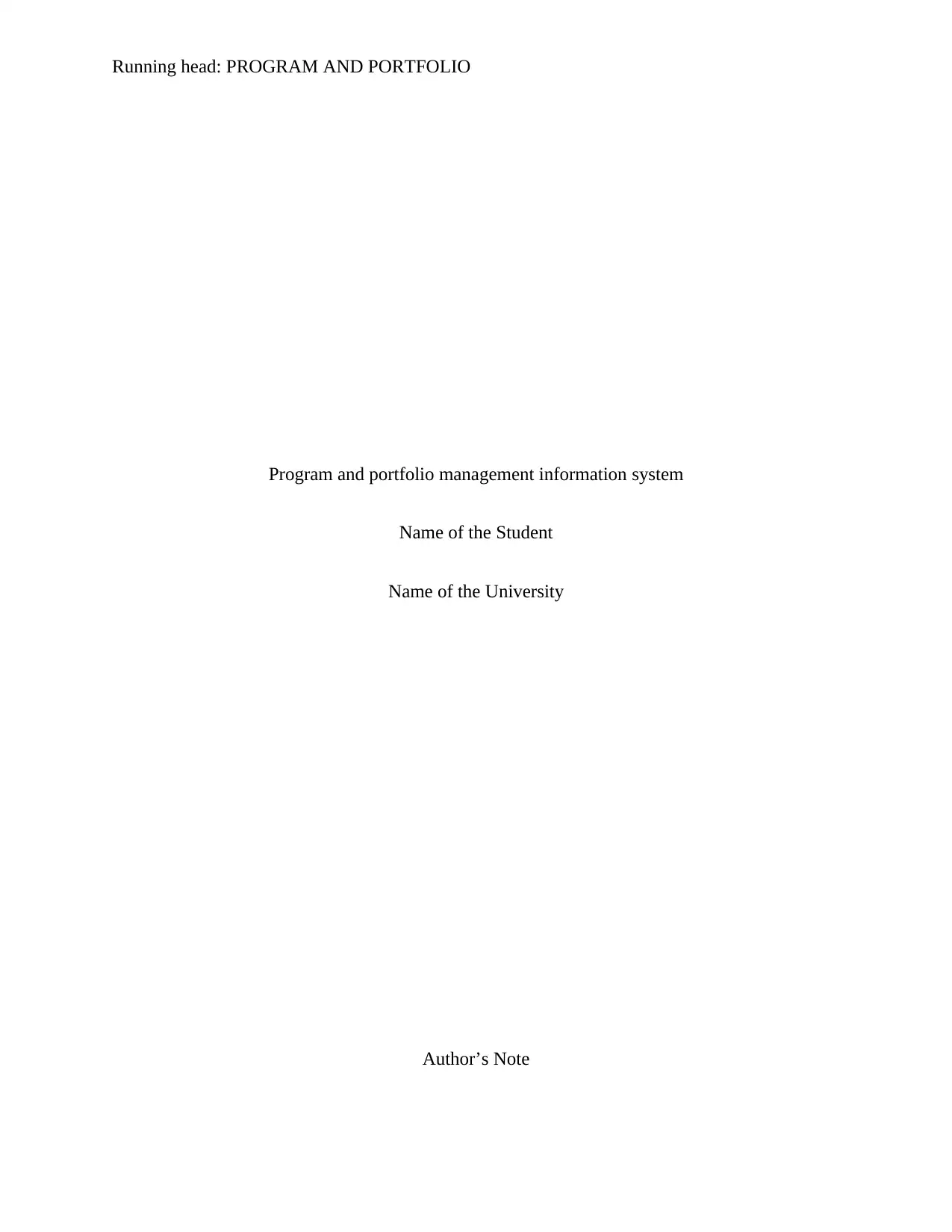
Running head: PROGRAM AND PORTFOLIO
Program and portfolio management information system
Name of the Student
Name of the University
Author’s Note
Program and portfolio management information system
Name of the Student
Name of the University
Author’s Note
Paraphrase This Document
Need a fresh take? Get an instant paraphrase of this document with our AI Paraphraser
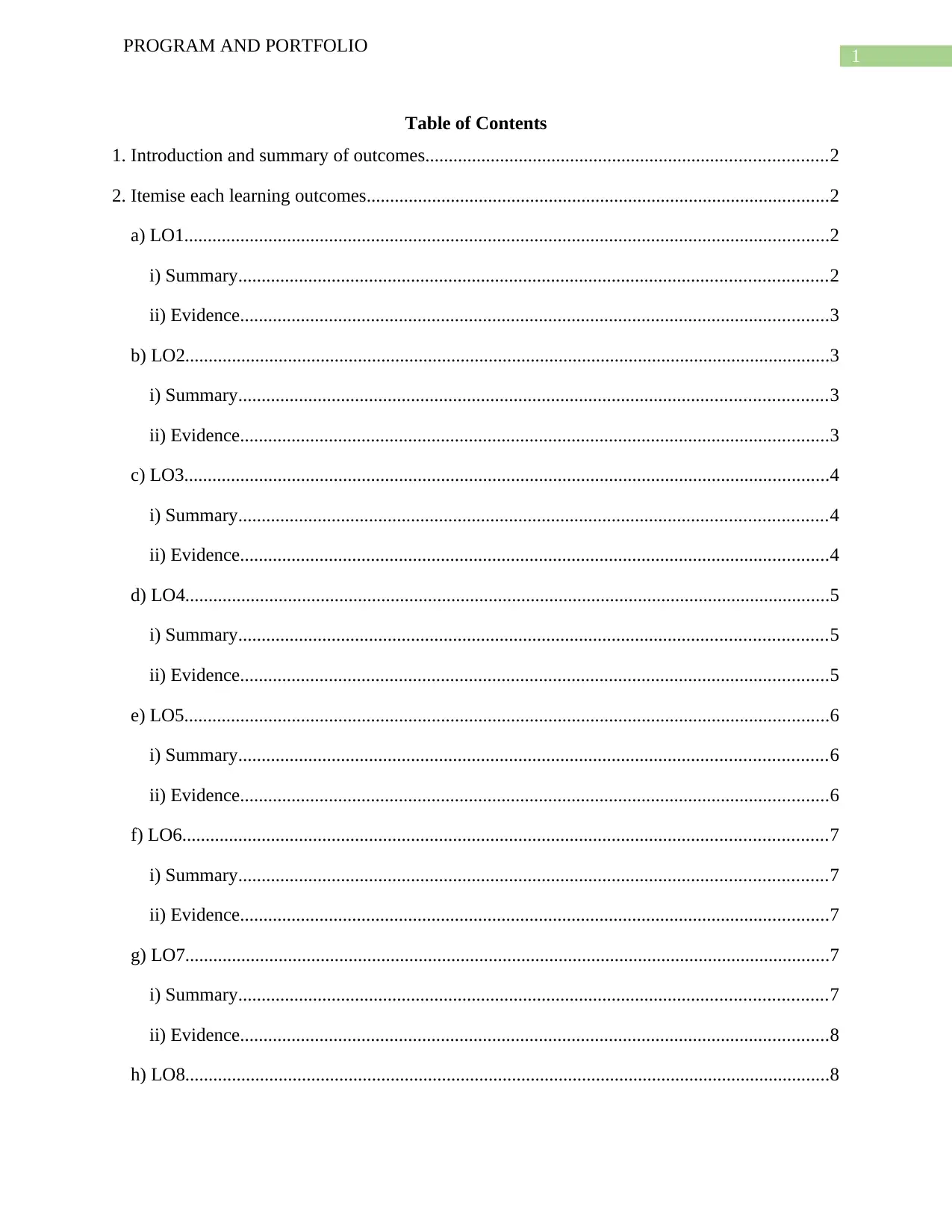
1
PROGRAM AND PORTFOLIO
Table of Contents
1. Introduction and summary of outcomes......................................................................................2
2. Itemise each learning outcomes...................................................................................................2
a) LO1..........................................................................................................................................2
i) Summary..............................................................................................................................2
ii) Evidence..............................................................................................................................3
b) LO2..........................................................................................................................................3
i) Summary..............................................................................................................................3
ii) Evidence..............................................................................................................................3
c) LO3..........................................................................................................................................4
i) Summary..............................................................................................................................4
ii) Evidence..............................................................................................................................4
d) LO4..........................................................................................................................................5
i) Summary..............................................................................................................................5
ii) Evidence..............................................................................................................................5
e) LO5..........................................................................................................................................6
i) Summary..............................................................................................................................6
ii) Evidence..............................................................................................................................6
f) LO6..........................................................................................................................................7
i) Summary..............................................................................................................................7
ii) Evidence..............................................................................................................................7
g) LO7..........................................................................................................................................7
i) Summary..............................................................................................................................7
ii) Evidence..............................................................................................................................8
h) LO8..........................................................................................................................................8
PROGRAM AND PORTFOLIO
Table of Contents
1. Introduction and summary of outcomes......................................................................................2
2. Itemise each learning outcomes...................................................................................................2
a) LO1..........................................................................................................................................2
i) Summary..............................................................................................................................2
ii) Evidence..............................................................................................................................3
b) LO2..........................................................................................................................................3
i) Summary..............................................................................................................................3
ii) Evidence..............................................................................................................................3
c) LO3..........................................................................................................................................4
i) Summary..............................................................................................................................4
ii) Evidence..............................................................................................................................4
d) LO4..........................................................................................................................................5
i) Summary..............................................................................................................................5
ii) Evidence..............................................................................................................................5
e) LO5..........................................................................................................................................6
i) Summary..............................................................................................................................6
ii) Evidence..............................................................................................................................6
f) LO6..........................................................................................................................................7
i) Summary..............................................................................................................................7
ii) Evidence..............................................................................................................................7
g) LO7..........................................................................................................................................7
i) Summary..............................................................................................................................7
ii) Evidence..............................................................................................................................8
h) LO8..........................................................................................................................................8
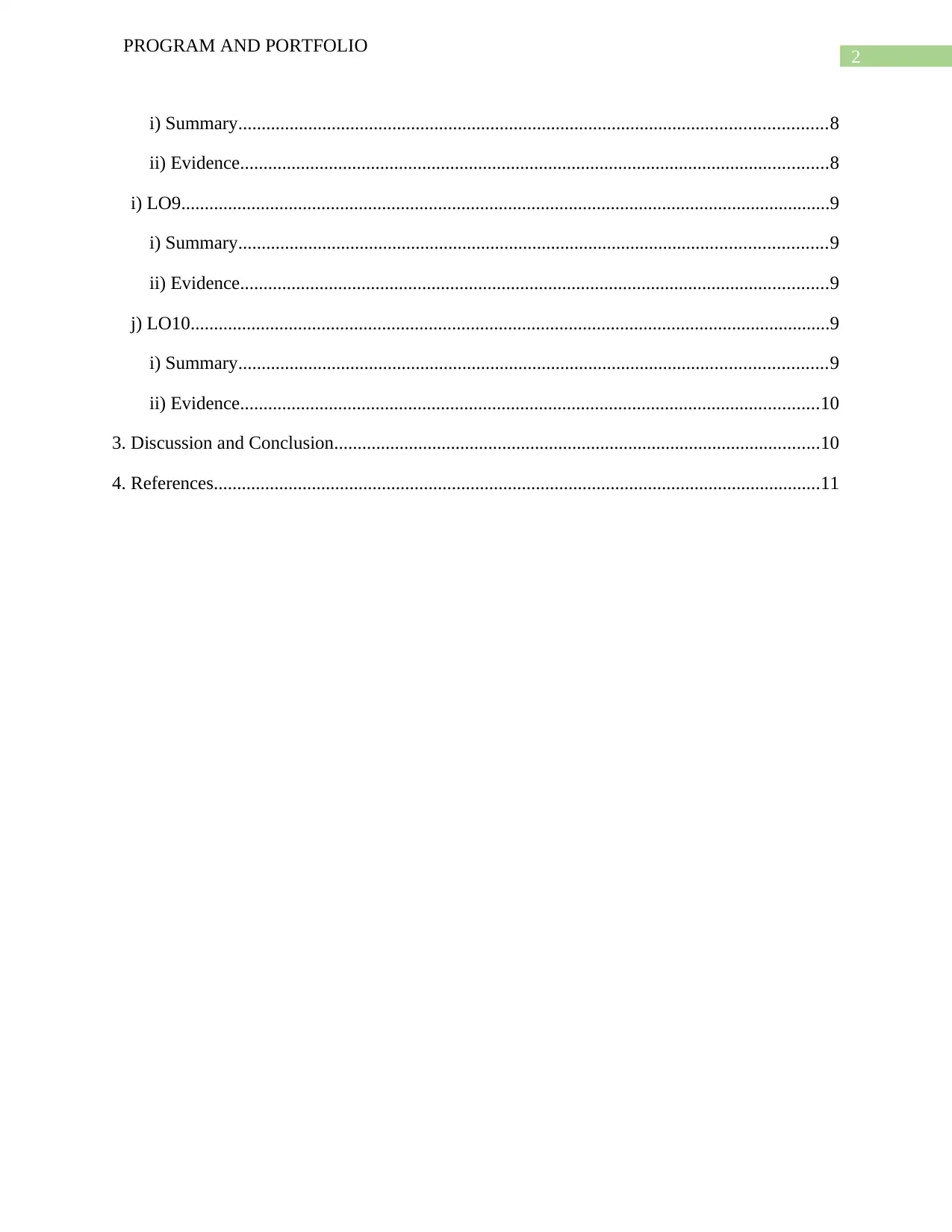
2
PROGRAM AND PORTFOLIO
i) Summary..............................................................................................................................8
ii) Evidence..............................................................................................................................8
i) LO9...........................................................................................................................................9
i) Summary..............................................................................................................................9
ii) Evidence..............................................................................................................................9
j) LO10.........................................................................................................................................9
i) Summary..............................................................................................................................9
ii) Evidence............................................................................................................................10
3. Discussion and Conclusion........................................................................................................10
4. References..................................................................................................................................11
PROGRAM AND PORTFOLIO
i) Summary..............................................................................................................................8
ii) Evidence..............................................................................................................................8
i) LO9...........................................................................................................................................9
i) Summary..............................................................................................................................9
ii) Evidence..............................................................................................................................9
j) LO10.........................................................................................................................................9
i) Summary..............................................................................................................................9
ii) Evidence............................................................................................................................10
3. Discussion and Conclusion........................................................................................................10
4. References..................................................................................................................................11
⊘ This is a preview!⊘
Do you want full access?
Subscribe today to unlock all pages.

Trusted by 1+ million students worldwide
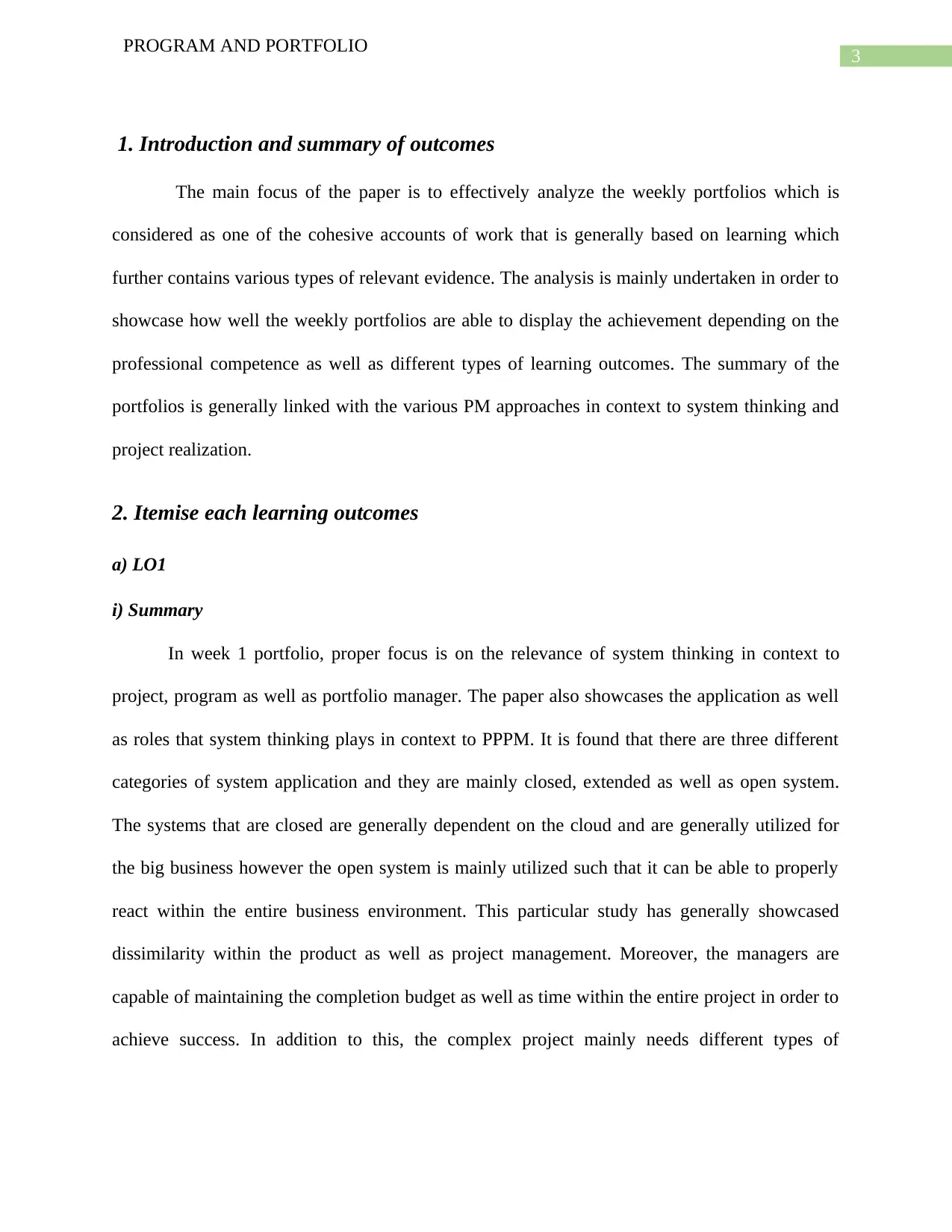
3
PROGRAM AND PORTFOLIO
1. Introduction and summary of outcomes
The main focus of the paper is to effectively analyze the weekly portfolios which is
considered as one of the cohesive accounts of work that is generally based on learning which
further contains various types of relevant evidence. The analysis is mainly undertaken in order to
showcase how well the weekly portfolios are able to display the achievement depending on the
professional competence as well as different types of learning outcomes. The summary of the
portfolios is generally linked with the various PM approaches in context to system thinking and
project realization.
2. Itemise each learning outcomes
a) LO1
i) Summary
In week 1 portfolio, proper focus is on the relevance of system thinking in context to
project, program as well as portfolio manager. The paper also showcases the application as well
as roles that system thinking plays in context to PPPM. It is found that there are three different
categories of system application and they are mainly closed, extended as well as open system.
The systems that are closed are generally dependent on the cloud and are generally utilized for
the big business however the open system is mainly utilized such that it can be able to properly
react within the entire business environment. This particular study has generally showcased
dissimilarity within the product as well as project management. Moreover, the managers are
capable of maintaining the completion budget as well as time within the entire project in order to
achieve success. In addition to this, the complex project mainly needs different types of
PROGRAM AND PORTFOLIO
1. Introduction and summary of outcomes
The main focus of the paper is to effectively analyze the weekly portfolios which is
considered as one of the cohesive accounts of work that is generally based on learning which
further contains various types of relevant evidence. The analysis is mainly undertaken in order to
showcase how well the weekly portfolios are able to display the achievement depending on the
professional competence as well as different types of learning outcomes. The summary of the
portfolios is generally linked with the various PM approaches in context to system thinking and
project realization.
2. Itemise each learning outcomes
a) LO1
i) Summary
In week 1 portfolio, proper focus is on the relevance of system thinking in context to
project, program as well as portfolio manager. The paper also showcases the application as well
as roles that system thinking plays in context to PPPM. It is found that there are three different
categories of system application and they are mainly closed, extended as well as open system.
The systems that are closed are generally dependent on the cloud and are generally utilized for
the big business however the open system is mainly utilized such that it can be able to properly
react within the entire business environment. This particular study has generally showcased
dissimilarity within the product as well as project management. Moreover, the managers are
capable of maintaining the completion budget as well as time within the entire project in order to
achieve success. In addition to this, the complex project mainly needs different types of
Paraphrase This Document
Need a fresh take? Get an instant paraphrase of this document with our AI Paraphraser
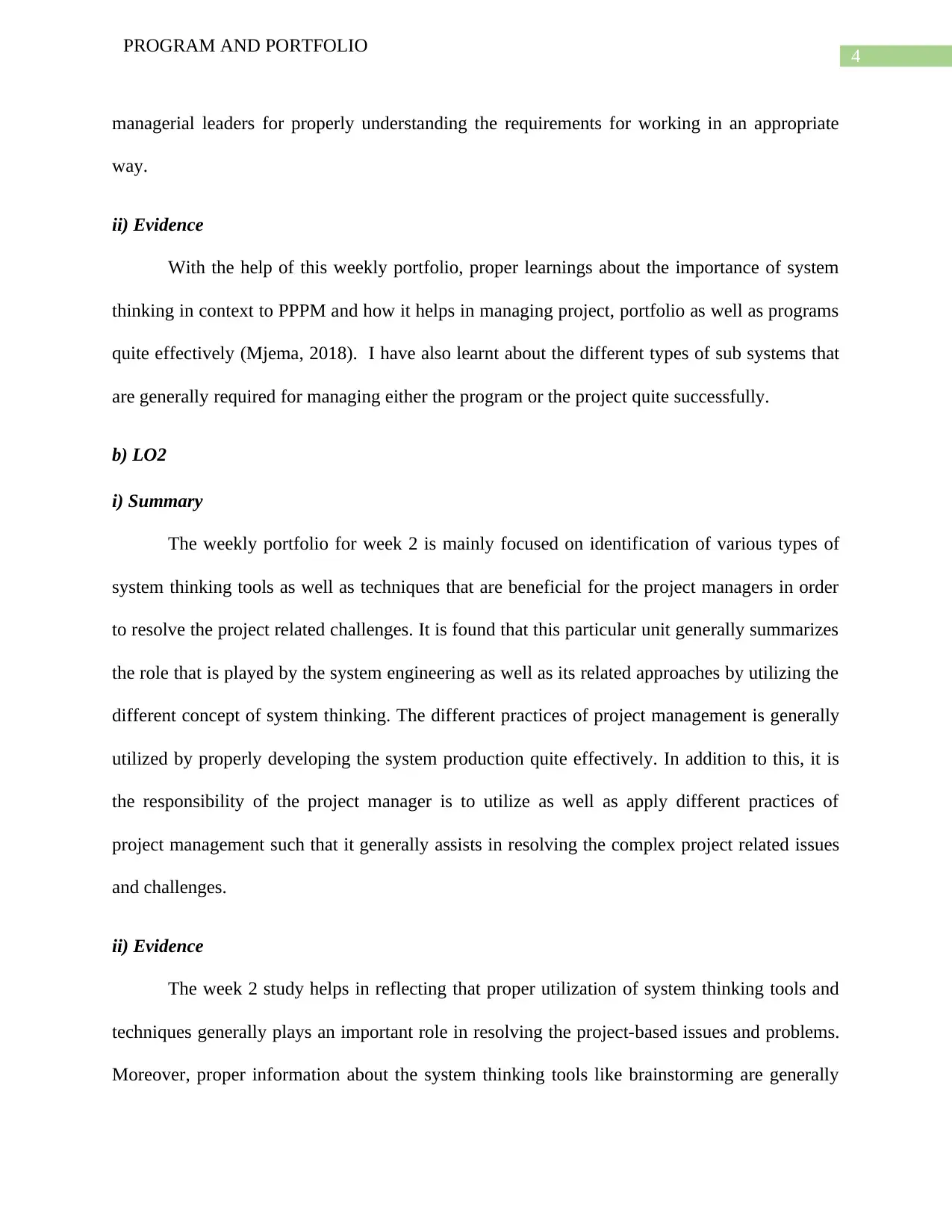
4
PROGRAM AND PORTFOLIO
managerial leaders for properly understanding the requirements for working in an appropriate
way.
ii) Evidence
With the help of this weekly portfolio, proper learnings about the importance of system
thinking in context to PPPM and how it helps in managing project, portfolio as well as programs
quite effectively (Mjema, 2018). I have also learnt about the different types of sub systems that
are generally required for managing either the program or the project quite successfully.
b) LO2
i) Summary
The weekly portfolio for week 2 is mainly focused on identification of various types of
system thinking tools as well as techniques that are beneficial for the project managers in order
to resolve the project related challenges. It is found that this particular unit generally summarizes
the role that is played by the system engineering as well as its related approaches by utilizing the
different concept of system thinking. The different practices of project management is generally
utilized by properly developing the system production quite effectively. In addition to this, it is
the responsibility of the project manager is to utilize as well as apply different practices of
project management such that it generally assists in resolving the complex project related issues
and challenges.
ii) Evidence
The week 2 study helps in reflecting that proper utilization of system thinking tools and
techniques generally plays an important role in resolving the project-based issues and problems.
Moreover, proper information about the system thinking tools like brainstorming are generally
PROGRAM AND PORTFOLIO
managerial leaders for properly understanding the requirements for working in an appropriate
way.
ii) Evidence
With the help of this weekly portfolio, proper learnings about the importance of system
thinking in context to PPPM and how it helps in managing project, portfolio as well as programs
quite effectively (Mjema, 2018). I have also learnt about the different types of sub systems that
are generally required for managing either the program or the project quite successfully.
b) LO2
i) Summary
The weekly portfolio for week 2 is mainly focused on identification of various types of
system thinking tools as well as techniques that are beneficial for the project managers in order
to resolve the project related challenges. It is found that this particular unit generally summarizes
the role that is played by the system engineering as well as its related approaches by utilizing the
different concept of system thinking. The different practices of project management is generally
utilized by properly developing the system production quite effectively. In addition to this, it is
the responsibility of the project manager is to utilize as well as apply different practices of
project management such that it generally assists in resolving the complex project related issues
and challenges.
ii) Evidence
The week 2 study helps in reflecting that proper utilization of system thinking tools and
techniques generally plays an important role in resolving the project-based issues and problems.
Moreover, proper information about the system thinking tools like brainstorming are generally
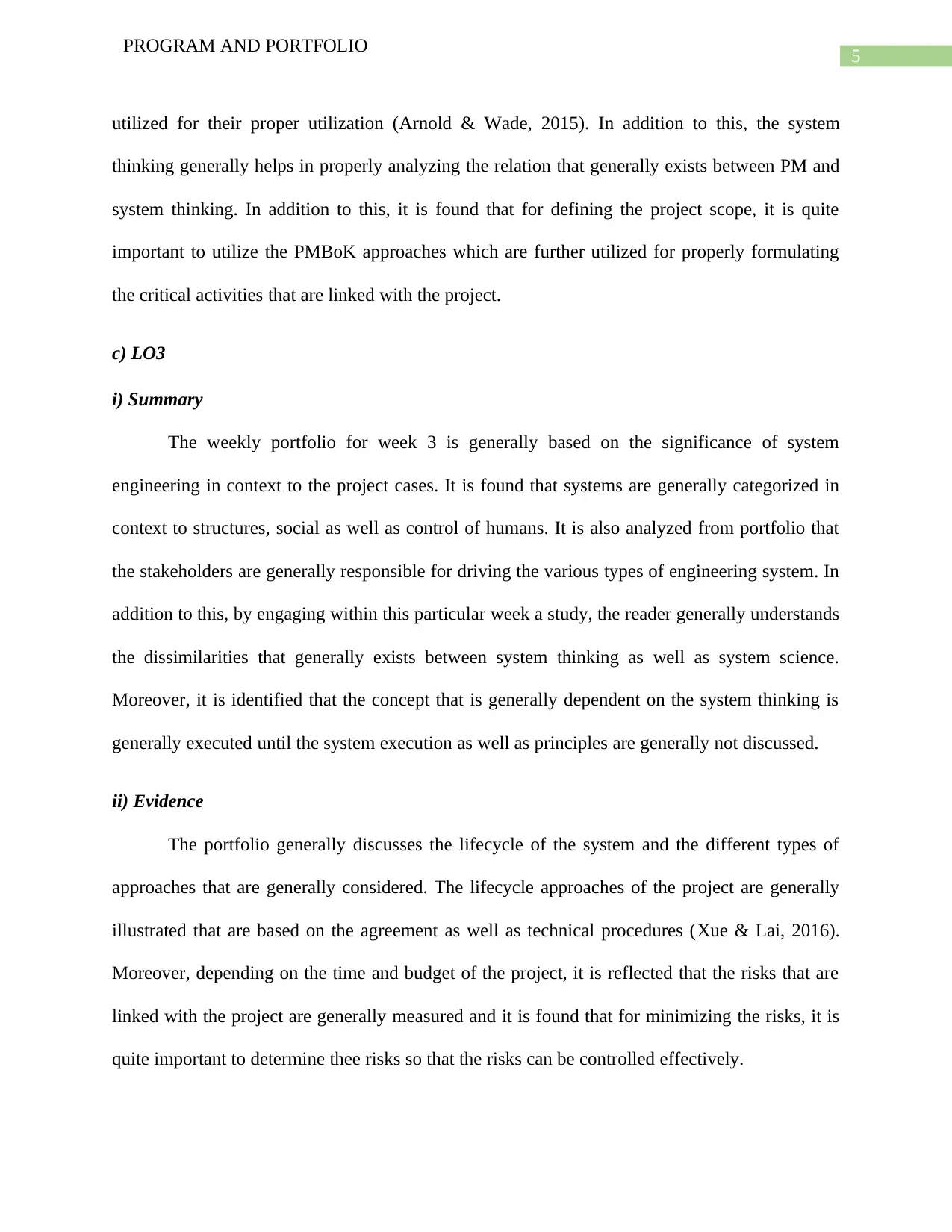
5
PROGRAM AND PORTFOLIO
utilized for their proper utilization (Arnold & Wade, 2015). In addition to this, the system
thinking generally helps in properly analyzing the relation that generally exists between PM and
system thinking. In addition to this, it is found that for defining the project scope, it is quite
important to utilize the PMBoK approaches which are further utilized for properly formulating
the critical activities that are linked with the project.
c) LO3
i) Summary
The weekly portfolio for week 3 is generally based on the significance of system
engineering in context to the project cases. It is found that systems are generally categorized in
context to structures, social as well as control of humans. It is also analyzed from portfolio that
the stakeholders are generally responsible for driving the various types of engineering system. In
addition to this, by engaging within this particular week a study, the reader generally understands
the dissimilarities that generally exists between system thinking as well as system science.
Moreover, it is identified that the concept that is generally dependent on the system thinking is
generally executed until the system execution as well as principles are generally not discussed.
ii) Evidence
The portfolio generally discusses the lifecycle of the system and the different types of
approaches that are generally considered. The lifecycle approaches of the project are generally
illustrated that are based on the agreement as well as technical procedures (Xue & Lai, 2016).
Moreover, depending on the time and budget of the project, it is reflected that the risks that are
linked with the project are generally measured and it is found that for minimizing the risks, it is
quite important to determine thee risks so that the risks can be controlled effectively.
PROGRAM AND PORTFOLIO
utilized for their proper utilization (Arnold & Wade, 2015). In addition to this, the system
thinking generally helps in properly analyzing the relation that generally exists between PM and
system thinking. In addition to this, it is found that for defining the project scope, it is quite
important to utilize the PMBoK approaches which are further utilized for properly formulating
the critical activities that are linked with the project.
c) LO3
i) Summary
The weekly portfolio for week 3 is generally based on the significance of system
engineering in context to the project cases. It is found that systems are generally categorized in
context to structures, social as well as control of humans. It is also analyzed from portfolio that
the stakeholders are generally responsible for driving the various types of engineering system. In
addition to this, by engaging within this particular week a study, the reader generally understands
the dissimilarities that generally exists between system thinking as well as system science.
Moreover, it is identified that the concept that is generally dependent on the system thinking is
generally executed until the system execution as well as principles are generally not discussed.
ii) Evidence
The portfolio generally discusses the lifecycle of the system and the different types of
approaches that are generally considered. The lifecycle approaches of the project are generally
illustrated that are based on the agreement as well as technical procedures (Xue & Lai, 2016).
Moreover, depending on the time and budget of the project, it is reflected that the risks that are
linked with the project are generally measured and it is found that for minimizing the risks, it is
quite important to determine thee risks so that the risks can be controlled effectively.
⊘ This is a preview!⊘
Do you want full access?
Subscribe today to unlock all pages.

Trusted by 1+ million students worldwide
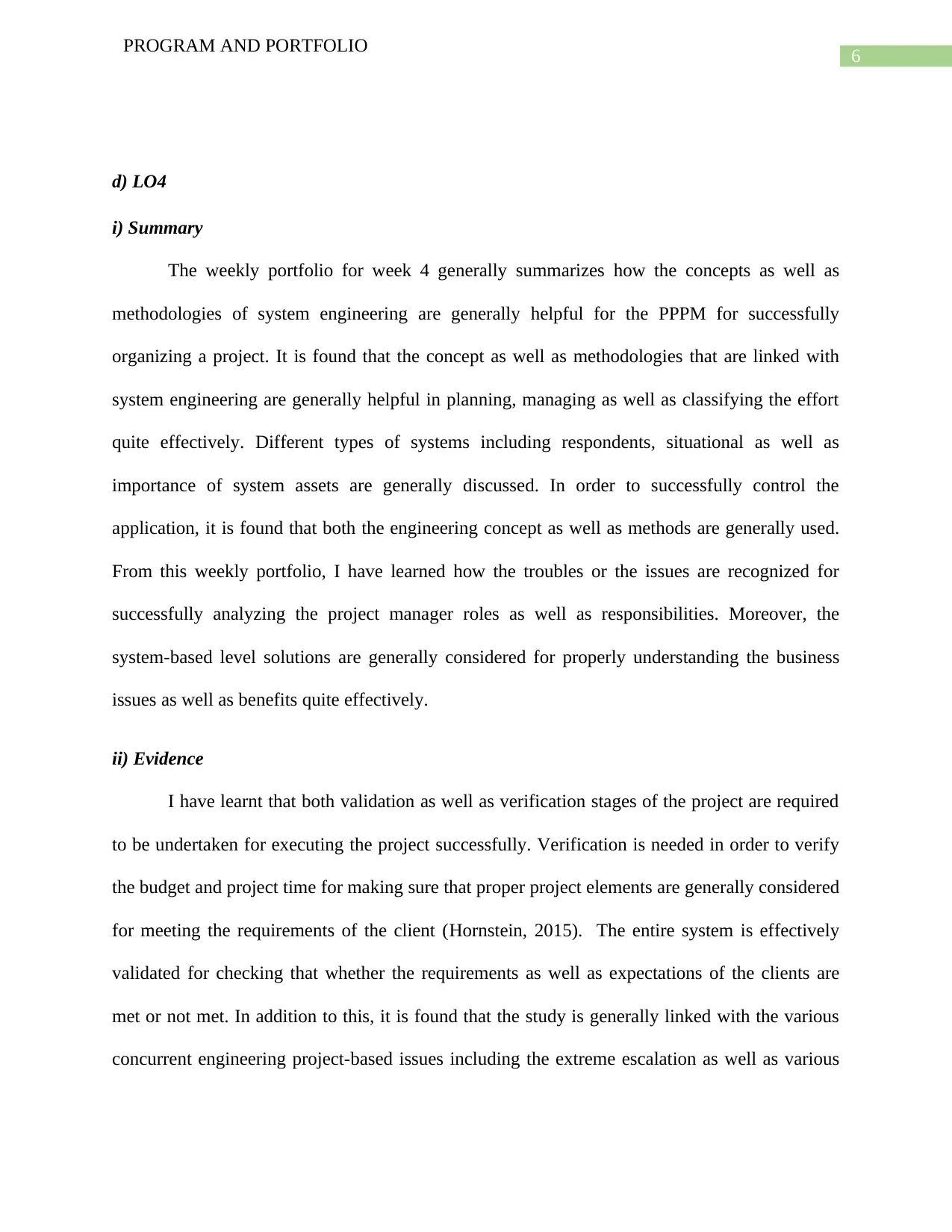
6
PROGRAM AND PORTFOLIO
d) LO4
i) Summary
The weekly portfolio for week 4 generally summarizes how the concepts as well as
methodologies of system engineering are generally helpful for the PPPM for successfully
organizing a project. It is found that the concept as well as methodologies that are linked with
system engineering are generally helpful in planning, managing as well as classifying the effort
quite effectively. Different types of systems including respondents, situational as well as
importance of system assets are generally discussed. In order to successfully control the
application, it is found that both the engineering concept as well as methods are generally used.
From this weekly portfolio, I have learned how the troubles or the issues are recognized for
successfully analyzing the project manager roles as well as responsibilities. Moreover, the
system-based level solutions are generally considered for properly understanding the business
issues as well as benefits quite effectively.
ii) Evidence
I have learnt that both validation as well as verification stages of the project are required
to be undertaken for executing the project successfully. Verification is needed in order to verify
the budget and project time for making sure that proper project elements are generally considered
for meeting the requirements of the client (Hornstein, 2015). The entire system is effectively
validated for checking that whether the requirements as well as expectations of the clients are
met or not met. In addition to this, it is found that the study is generally linked with the various
concurrent engineering project-based issues including the extreme escalation as well as various
PROGRAM AND PORTFOLIO
d) LO4
i) Summary
The weekly portfolio for week 4 generally summarizes how the concepts as well as
methodologies of system engineering are generally helpful for the PPPM for successfully
organizing a project. It is found that the concept as well as methodologies that are linked with
system engineering are generally helpful in planning, managing as well as classifying the effort
quite effectively. Different types of systems including respondents, situational as well as
importance of system assets are generally discussed. In order to successfully control the
application, it is found that both the engineering concept as well as methods are generally used.
From this weekly portfolio, I have learned how the troubles or the issues are recognized for
successfully analyzing the project manager roles as well as responsibilities. Moreover, the
system-based level solutions are generally considered for properly understanding the business
issues as well as benefits quite effectively.
ii) Evidence
I have learnt that both validation as well as verification stages of the project are required
to be undertaken for executing the project successfully. Verification is needed in order to verify
the budget and project time for making sure that proper project elements are generally considered
for meeting the requirements of the client (Hornstein, 2015). The entire system is effectively
validated for checking that whether the requirements as well as expectations of the clients are
met or not met. In addition to this, it is found that the study is generally linked with the various
concurrent engineering project-based issues including the extreme escalation as well as various
Paraphrase This Document
Need a fresh take? Get an instant paraphrase of this document with our AI Paraphraser
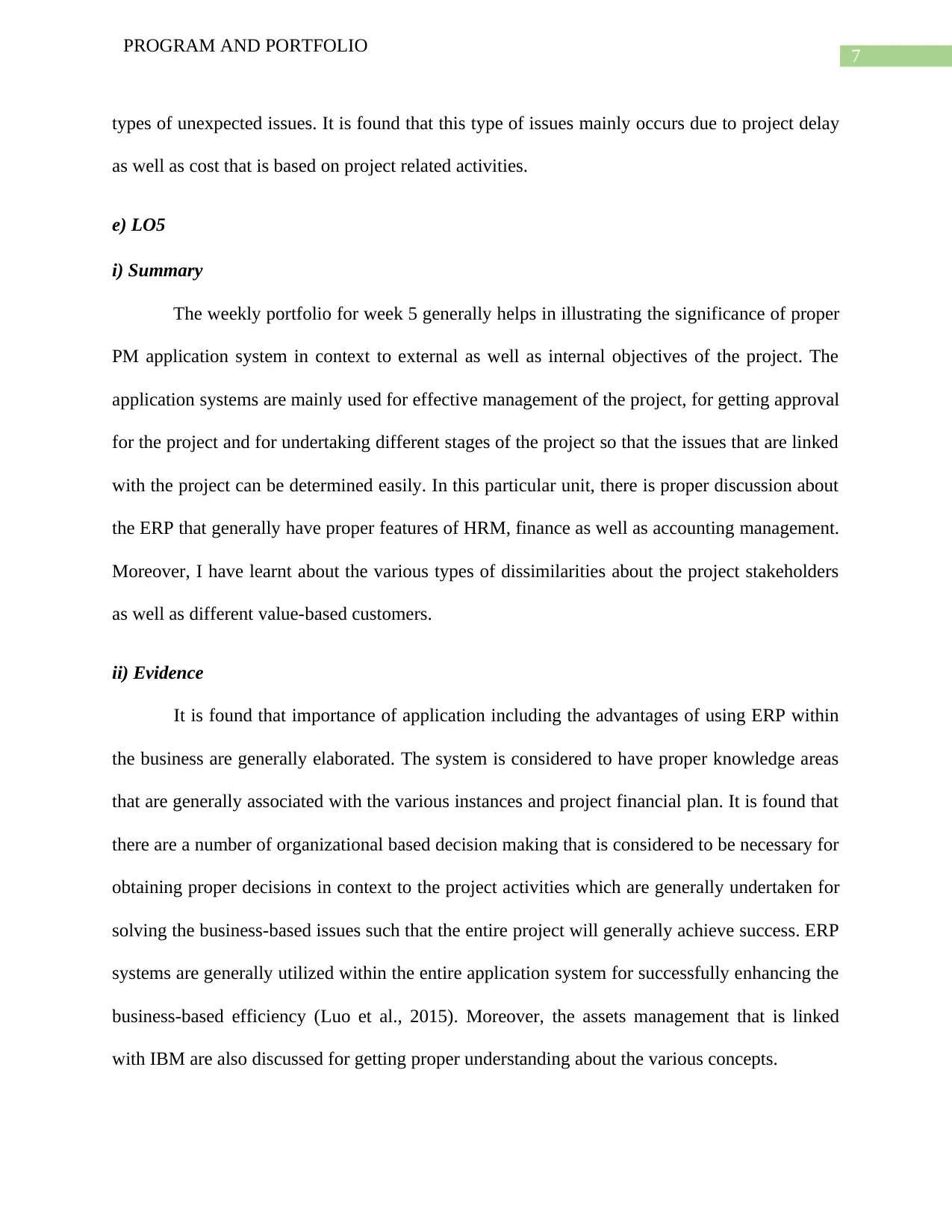
7
PROGRAM AND PORTFOLIO
types of unexpected issues. It is found that this type of issues mainly occurs due to project delay
as well as cost that is based on project related activities.
e) LO5
i) Summary
The weekly portfolio for week 5 generally helps in illustrating the significance of proper
PM application system in context to external as well as internal objectives of the project. The
application systems are mainly used for effective management of the project, for getting approval
for the project and for undertaking different stages of the project so that the issues that are linked
with the project can be determined easily. In this particular unit, there is proper discussion about
the ERP that generally have proper features of HRM, finance as well as accounting management.
Moreover, I have learnt about the various types of dissimilarities about the project stakeholders
as well as different value-based customers.
ii) Evidence
It is found that importance of application including the advantages of using ERP within
the business are generally elaborated. The system is considered to have proper knowledge areas
that are generally associated with the various instances and project financial plan. It is found that
there are a number of organizational based decision making that is considered to be necessary for
obtaining proper decisions in context to the project activities which are generally undertaken for
solving the business-based issues such that the entire project will generally achieve success. ERP
systems are generally utilized within the entire application system for successfully enhancing the
business-based efficiency (Luo et al., 2015). Moreover, the assets management that is linked
with IBM are also discussed for getting proper understanding about the various concepts.
PROGRAM AND PORTFOLIO
types of unexpected issues. It is found that this type of issues mainly occurs due to project delay
as well as cost that is based on project related activities.
e) LO5
i) Summary
The weekly portfolio for week 5 generally helps in illustrating the significance of proper
PM application system in context to external as well as internal objectives of the project. The
application systems are mainly used for effective management of the project, for getting approval
for the project and for undertaking different stages of the project so that the issues that are linked
with the project can be determined easily. In this particular unit, there is proper discussion about
the ERP that generally have proper features of HRM, finance as well as accounting management.
Moreover, I have learnt about the various types of dissimilarities about the project stakeholders
as well as different value-based customers.
ii) Evidence
It is found that importance of application including the advantages of using ERP within
the business are generally elaborated. The system is considered to have proper knowledge areas
that are generally associated with the various instances and project financial plan. It is found that
there are a number of organizational based decision making that is considered to be necessary for
obtaining proper decisions in context to the project activities which are generally undertaken for
solving the business-based issues such that the entire project will generally achieve success. ERP
systems are generally utilized within the entire application system for successfully enhancing the
business-based efficiency (Luo et al., 2015). Moreover, the assets management that is linked
with IBM are also discussed for getting proper understanding about the various concepts.
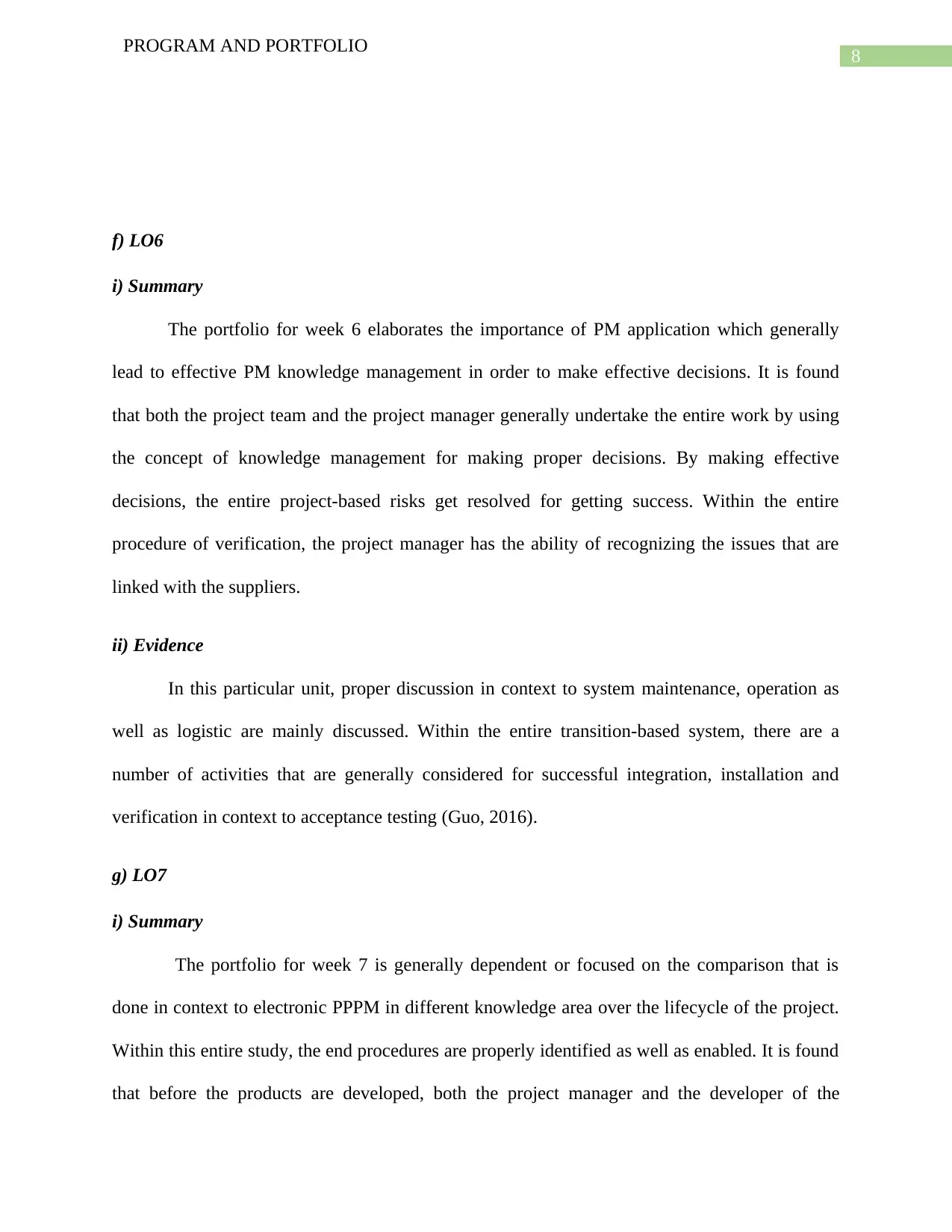
8
PROGRAM AND PORTFOLIO
f) LO6
i) Summary
The portfolio for week 6 elaborates the importance of PM application which generally
lead to effective PM knowledge management in order to make effective decisions. It is found
that both the project team and the project manager generally undertake the entire work by using
the concept of knowledge management for making proper decisions. By making effective
decisions, the entire project-based risks get resolved for getting success. Within the entire
procedure of verification, the project manager has the ability of recognizing the issues that are
linked with the suppliers.
ii) Evidence
In this particular unit, proper discussion in context to system maintenance, operation as
well as logistic are mainly discussed. Within the entire transition-based system, there are a
number of activities that are generally considered for successful integration, installation and
verification in context to acceptance testing (Guo, 2016).
g) LO7
i) Summary
The portfolio for week 7 is generally dependent or focused on the comparison that is
done in context to electronic PPPM in different knowledge area over the lifecycle of the project.
Within this entire study, the end procedures are properly identified as well as enabled. It is found
that before the products are developed, both the project manager and the developer of the
PROGRAM AND PORTFOLIO
f) LO6
i) Summary
The portfolio for week 6 elaborates the importance of PM application which generally
lead to effective PM knowledge management in order to make effective decisions. It is found
that both the project team and the project manager generally undertake the entire work by using
the concept of knowledge management for making proper decisions. By making effective
decisions, the entire project-based risks get resolved for getting success. Within the entire
procedure of verification, the project manager has the ability of recognizing the issues that are
linked with the suppliers.
ii) Evidence
In this particular unit, proper discussion in context to system maintenance, operation as
well as logistic are mainly discussed. Within the entire transition-based system, there are a
number of activities that are generally considered for successful integration, installation and
verification in context to acceptance testing (Guo, 2016).
g) LO7
i) Summary
The portfolio for week 7 is generally dependent or focused on the comparison that is
done in context to electronic PPPM in different knowledge area over the lifecycle of the project.
Within this entire study, the end procedures are properly identified as well as enabled. It is found
that before the products are developed, both the project manager and the developer of the
⊘ This is a preview!⊘
Do you want full access?
Subscribe today to unlock all pages.

Trusted by 1+ million students worldwide
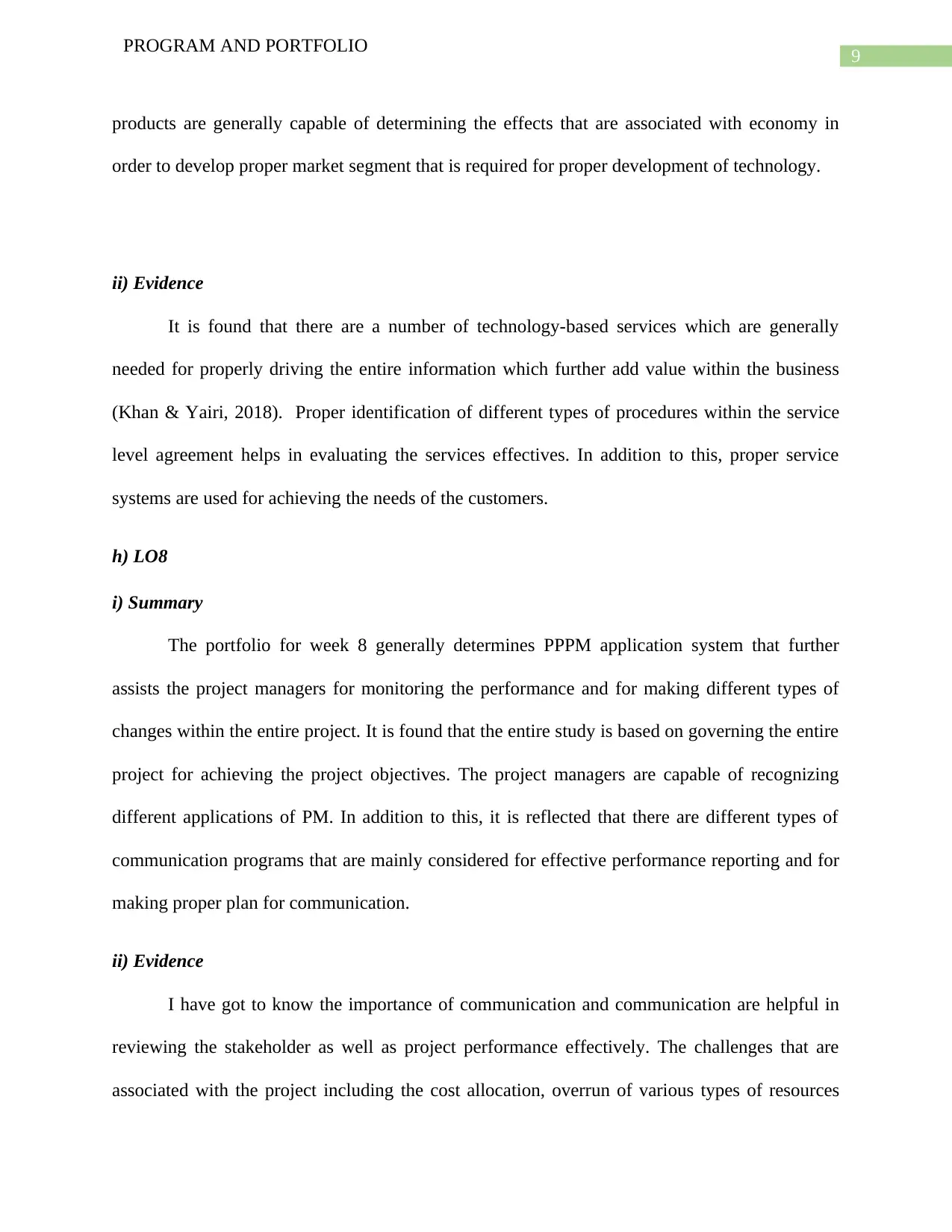
9
PROGRAM AND PORTFOLIO
products are generally capable of determining the effects that are associated with economy in
order to develop proper market segment that is required for proper development of technology.
ii) Evidence
It is found that there are a number of technology-based services which are generally
needed for properly driving the entire information which further add value within the business
(Khan & Yairi, 2018). Proper identification of different types of procedures within the service
level agreement helps in evaluating the services effectives. In addition to this, proper service
systems are used for achieving the needs of the customers.
h) LO8
i) Summary
The portfolio for week 8 generally determines PPPM application system that further
assists the project managers for monitoring the performance and for making different types of
changes within the entire project. It is found that the entire study is based on governing the entire
project for achieving the project objectives. The project managers are capable of recognizing
different applications of PM. In addition to this, it is reflected that there are different types of
communication programs that are mainly considered for effective performance reporting and for
making proper plan for communication.
ii) Evidence
I have got to know the importance of communication and communication are helpful in
reviewing the stakeholder as well as project performance effectively. The challenges that are
associated with the project including the cost allocation, overrun of various types of resources
PROGRAM AND PORTFOLIO
products are generally capable of determining the effects that are associated with economy in
order to develop proper market segment that is required for proper development of technology.
ii) Evidence
It is found that there are a number of technology-based services which are generally
needed for properly driving the entire information which further add value within the business
(Khan & Yairi, 2018). Proper identification of different types of procedures within the service
level agreement helps in evaluating the services effectives. In addition to this, proper service
systems are used for achieving the needs of the customers.
h) LO8
i) Summary
The portfolio for week 8 generally determines PPPM application system that further
assists the project managers for monitoring the performance and for making different types of
changes within the entire project. It is found that the entire study is based on governing the entire
project for achieving the project objectives. The project managers are capable of recognizing
different applications of PM. In addition to this, it is reflected that there are different types of
communication programs that are mainly considered for effective performance reporting and for
making proper plan for communication.
ii) Evidence
I have got to know the importance of communication and communication are helpful in
reviewing the stakeholder as well as project performance effectively. The challenges that are
associated with the project including the cost allocation, overrun of various types of resources
Paraphrase This Document
Need a fresh take? Get an instant paraphrase of this document with our AI Paraphraser
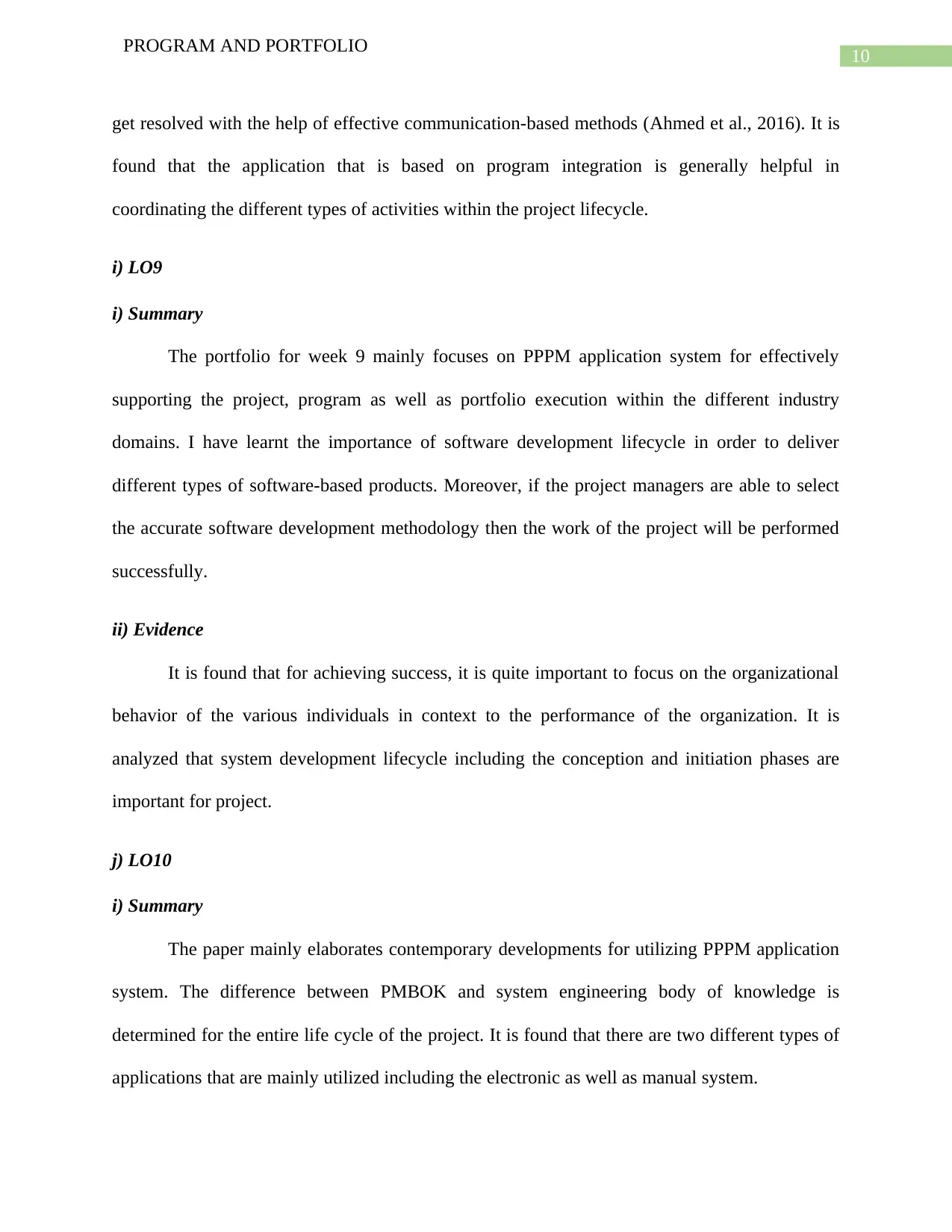
10
PROGRAM AND PORTFOLIO
get resolved with the help of effective communication-based methods (Ahmed et al., 2016). It is
found that the application that is based on program integration is generally helpful in
coordinating the different types of activities within the project lifecycle.
i) LO9
i) Summary
The portfolio for week 9 mainly focuses on PPPM application system for effectively
supporting the project, program as well as portfolio execution within the different industry
domains. I have learnt the importance of software development lifecycle in order to deliver
different types of software-based products. Moreover, if the project managers are able to select
the accurate software development methodology then the work of the project will be performed
successfully.
ii) Evidence
It is found that for achieving success, it is quite important to focus on the organizational
behavior of the various individuals in context to the performance of the organization. It is
analyzed that system development lifecycle including the conception and initiation phases are
important for project.
j) LO10
i) Summary
The paper mainly elaborates contemporary developments for utilizing PPPM application
system. The difference between PMBOK and system engineering body of knowledge is
determined for the entire life cycle of the project. It is found that there are two different types of
applications that are mainly utilized including the electronic as well as manual system.
PROGRAM AND PORTFOLIO
get resolved with the help of effective communication-based methods (Ahmed et al., 2016). It is
found that the application that is based on program integration is generally helpful in
coordinating the different types of activities within the project lifecycle.
i) LO9
i) Summary
The portfolio for week 9 mainly focuses on PPPM application system for effectively
supporting the project, program as well as portfolio execution within the different industry
domains. I have learnt the importance of software development lifecycle in order to deliver
different types of software-based products. Moreover, if the project managers are able to select
the accurate software development methodology then the work of the project will be performed
successfully.
ii) Evidence
It is found that for achieving success, it is quite important to focus on the organizational
behavior of the various individuals in context to the performance of the organization. It is
analyzed that system development lifecycle including the conception and initiation phases are
important for project.
j) LO10
i) Summary
The paper mainly elaborates contemporary developments for utilizing PPPM application
system. The difference between PMBOK and system engineering body of knowledge is
determined for the entire life cycle of the project. It is found that there are two different types of
applications that are mainly utilized including the electronic as well as manual system.
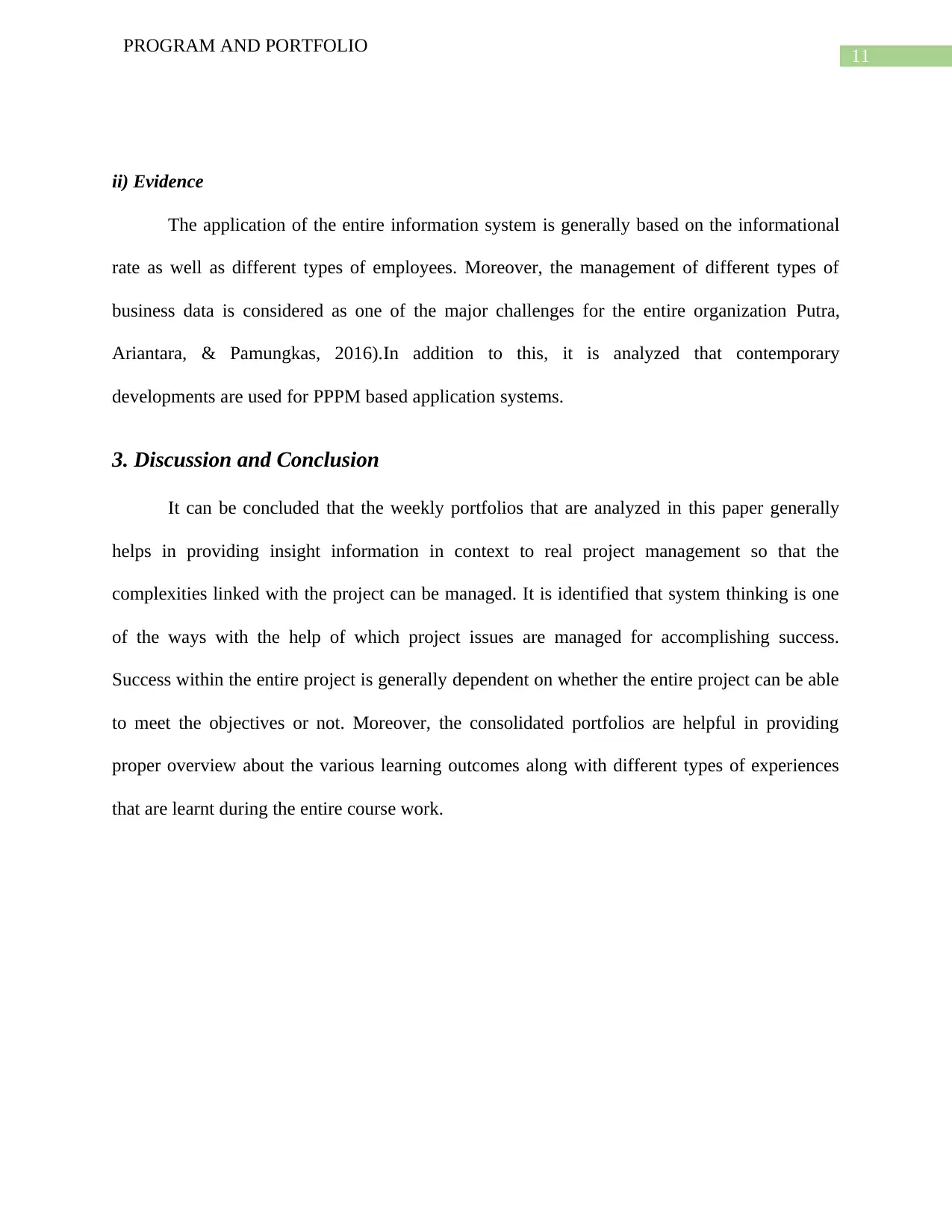
11
PROGRAM AND PORTFOLIO
ii) Evidence
The application of the entire information system is generally based on the informational
rate as well as different types of employees. Moreover, the management of different types of
business data is considered as one of the major challenges for the entire organization Putra,
Ariantara, & Pamungkas, 2016).In addition to this, it is analyzed that contemporary
developments are used for PPPM based application systems.
3. Discussion and Conclusion
It can be concluded that the weekly portfolios that are analyzed in this paper generally
helps in providing insight information in context to real project management so that the
complexities linked with the project can be managed. It is identified that system thinking is one
of the ways with the help of which project issues are managed for accomplishing success.
Success within the entire project is generally dependent on whether the entire project can be able
to meet the objectives or not. Moreover, the consolidated portfolios are helpful in providing
proper overview about the various learning outcomes along with different types of experiences
that are learnt during the entire course work.
PROGRAM AND PORTFOLIO
ii) Evidence
The application of the entire information system is generally based on the informational
rate as well as different types of employees. Moreover, the management of different types of
business data is considered as one of the major challenges for the entire organization Putra,
Ariantara, & Pamungkas, 2016).In addition to this, it is analyzed that contemporary
developments are used for PPPM based application systems.
3. Discussion and Conclusion
It can be concluded that the weekly portfolios that are analyzed in this paper generally
helps in providing insight information in context to real project management so that the
complexities linked with the project can be managed. It is identified that system thinking is one
of the ways with the help of which project issues are managed for accomplishing success.
Success within the entire project is generally dependent on whether the entire project can be able
to meet the objectives or not. Moreover, the consolidated portfolios are helpful in providing
proper overview about the various learning outcomes along with different types of experiences
that are learnt during the entire course work.
⊘ This is a preview!⊘
Do you want full access?
Subscribe today to unlock all pages.

Trusted by 1+ million students worldwide
1 out of 14
Related Documents
Your All-in-One AI-Powered Toolkit for Academic Success.
+13062052269
info@desklib.com
Available 24*7 on WhatsApp / Email
![[object Object]](/_next/static/media/star-bottom.7253800d.svg)
Unlock your academic potential
Copyright © 2020–2025 A2Z Services. All Rights Reserved. Developed and managed by ZUCOL.




